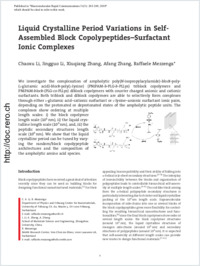Liquid crystalline period variations in self-assembled block copolypeptides-surfactant ionic complexes
- Li, Chaoxu Department of Physics and Fribourg Center for Nanomaterials, University of Fribourg, Switzerland
- Li, Jingguo School of Materials Science and Engineering, Zhengzhou University, China
- Zhang, Xiuqiang School of Materials Science and Engineering, Zhengzhou University, China
- Zhang, Afang School of Materials Science and Engineering, Zhengzhou University, China
- Mezzenga, Raffaele Department of Physics and Fribourg Center for Nanomaterials, University of Fribourg, Switzerland - Nestlé Research Center, Lausanne, Switzerland
-
01.12.2009
Published in:
- Macromolecular Rapid Communications. - 2010, vol. 31, no. 3, p. 265-269
comb-like polymers
complexes
ionic complexes
polypeptides
side chain surfactants
supramolecular chemistry
English
We investigate the complexation of ampholytic poly(N-isopropylacylamide)-block-poly- (L-glutamic acid)-block-poly(L-lysine) (PNiPAM-b-PLG-b-PLLys) triblock copolymers and PNiPAM-block-(PLG-co-PLLys) diblock copolymers with counter charged anionic and cationic surfactants. Both triblock and diblock copolymers are able to selectively form complexes through either L-glutamic acid-cationic surfactant or L-lysine-anionic surfactant ionic pairs, depending on the protonated or deprotonated states of the ampholytic peptide units. The complexes show ordering at multiple length scales: i) the block copolymer length scale (10¹ nm), ii) the liquid crystalline length scale (10⁰ nm), and, iii) the peptidic secondary structures length scale (10⁰ nm). We show that the liquid crystalline period can be tuned by varying the random/block copolypeptide architectures and the composition of the ampholytic amino acid species.
- Faculty
- Faculté des sciences et de médecine
- Department
- Département de Physique
- Language
-
- English
- Classification
- Physics
- License
-
License undefined
- Identifiers
-
- RERO DOC 17364
- DOI 10.1002/marc.200900633
- Persistent URL
- https://folia.unifr.ch/unifr/documents/301372
Statistics
Document views: 123
File downloads:
- pdf: 194
